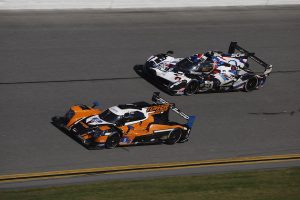CONCORD, N.C. — The auto-racing season just past was one of the most interesting in recent memory, at least to this writer. In addition to the thrilling on-track action, I wonder what’s in store this year for the sport we all know and love.
The racing in 2022 was intense, from the openers to the finales, and featured quite a few stirring drives, some of them epic in their greatness.
Anyone who watched the final hours of the annual Petit Le Mans at Georgia’s Road Atlanta got a season’s worth of action in one 10-hour chunk. Prototypes were flying all over the yard, the lead changed hands several times in the final hour — shoot, it changed hands in the final few laps — and that’s odd for an endurance race of this magnitude.

I couldn’t help but feel for Wayne Taylor and the rest of his team, as victory and a championship were snatched away in that final, dizzying sequence.
The Petit Le Mans is one of my favorite races, having attended the inaugural way back in the day while in the employ of SPEED SPORT. That was the race in which Yannick Dalmas did the blow-over coming down the hill toward turn 10 in his Porsche GT1. That’s about the only thing that didn’t happen in this year’s race.
Road Atlanta is a fantastic race course, especially for IMSA sports cars, and the annual 10-hour battle is the season-ender, so it takes on special meaning.
In this case, it was Meyer Shank Racing and Wayne Taylor Racing battling to the end, and the WTR group suffered an accident with four laps remaining, costing them the title.
Endurance racing is an animal all its own, and while time-consuming, is still vastly entertaining. To put speed on track for three times the length of your normal NASCAR race is quite an undertaking. The conditions change from start to finish, often quite suddenly, and the team that adjusts the best usually wins.
As with the Rolex 24 At Daytona, the 12 Hours of Sebring, the Sahlen’s 6 Hours of the Glen and, of course, the 24 Hours of Le Mans, the Petit Le Mans is a date you circle on the calendar.
There is a definite strategy to endurance racing, as there is with any other type of motorsports. It’s not “show up, shut up and race.” Rather, it’s calculations, pace, tire strategy and, of course, luck. The IMSA group does it well and they’ll do it with a new machine this coming year.
The Hypercar era is here, and features hybrid drives as well as normal petrol-powered engines. The DPi format officially ended with the Petit Le Mans.
This will be interesting, as the cars will be eligible for both the IMSA WeatherTech SportsCar Championship and the World Endurance Championship. That means they can all run at Le Mans, which in the vernacular of the youth today, will be “lit.”
It is generally accepted as true that today’s race fan has a somewhat shorter attention span compared to older generations, so this could be an interesting experiment. NASCAR races still take right at four hours, after all, and NHRA drag races drag out all day long, if you’ll pardon the pun, thanks to so many classes.
This new breed of endurance racer calls back to the old Ferrari and Porsche beasties that terrorized Le Mans during the 1970s, at least to me (and now I have to dig out my VHS copy of “Le Mans” starring Steve McQueen! Where did I put that?).
Endurance racing isn’t for everyone and even I will watch the start, tune in at the two-hour mark and then watch the final hour or so. Unless you buy the streaming package, you can’t watch Le Mans, the 24 hours of Spa or the Nürburgring all the way through.
Even so, it’s a heck of a way to spend a day, and with the new cars, I’m willing to invest more in it this coming year.
It is nice to see the emphasis on the classic modes of motorsports, despite the questions that need to be answered about the state of the sport going forward.
The trend toward de-emphasizing personal transportation over mass-transit options is disturbing, yet I feel there is a long way to travel before that becomes a tipping point.
This story appeared in the Jan. 4 edition of the SPEED SPORT Insider.

